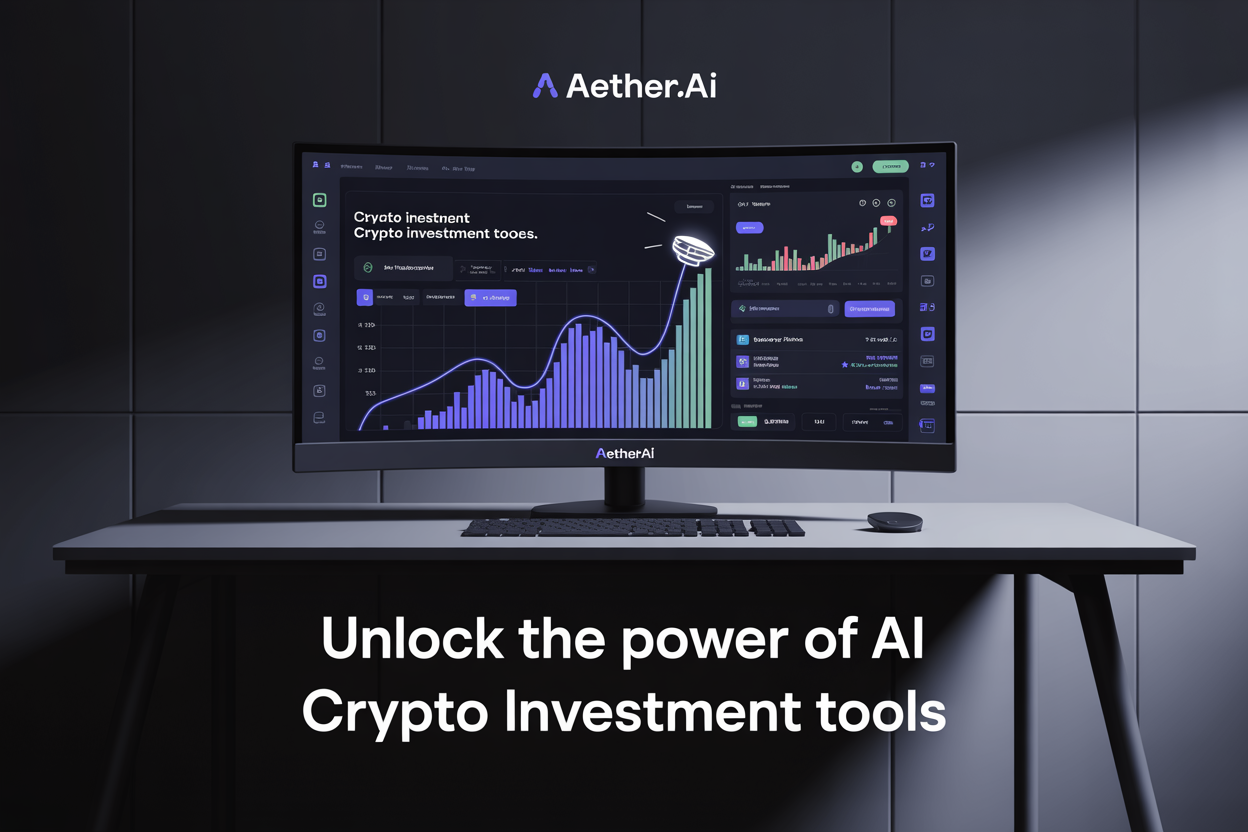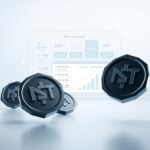Now Reading: How to Use Machine Learning for Profitable Crypto Trading
- 01
How to Use Machine Learning for Profitable Crypto Trading
How to Use Machine Learning for Profitable Crypto Trading

The world of crypto trading is changing fast. New tech is coming out to help traders make better choices. Machine learning is one of these technologies, and it could change trading forever.

Traders can use machine learning algorithms to look at lots of data. They can spot patterns and guess what the market might do next. This helps traders make smarter choices and earn more money.
Machine learning has many uses in crypto trading. It offers lots of benefits for traders who use it.
Key Takeaways
- Machine learning can analyze large datasets to predict market trends.
- Crypto trading benefits from accurate market predictions.
- Traders can maximize profits using machine learning insights.
- Machine learning algorithms can identify complex patterns.
- Crypto market analysis is enhanced with machine learning.
Understanding the Intersection of Machine Learning and Cryptocurrency
Machine learning is growing, and it’s changing how we trade cryptocurrencies. The cryptocurrency market is very volatile and complex. This makes it perfect for machine learning algorithms.
What Makes Crypto Markets Unique for ML Applications
Crypto markets never stop, creating a lot of data. Machine learning can analyze this data to predict trends and find good trading times. AI trading strategies can do this much faster and better than people.
The Evolution of Algorithmic Trading in Cryptocurrency
Algorithmic trading has been around in traditional finance for a while. It’s now being used in crypto too. It uses cryptocurrency algorithms to make trades based on set rules.
Key Advantages Over Traditional Trading Methods
Using machine learning in crypto trading has big benefits. It removes emotional decisions, trades faster, and watches markets all the time. These AI-driven strategies can also change with the market. This could lead to more money made from trading.
Benefits of Machine Learning Crypto Trading
Machine learning has changed how traders work. It uses smart algorithms and lots of data. This helps traders make better choices and trade more accurately.
Eliminating Emotional Decision-Making
One big plus of machine learning in crypto trading is avoiding emotional choices. Automated trading systems stick to plans, not emotions like fear or greed. This stops quick, emotional decisions.
Processing Vast Amounts of Market Data
Machine learning can handle huge amounts of data fast. It spots trends and patterns that humans might miss. This lets traders make smart choices and stay ahead.
24/7 Market Monitoring and Execution
Crypto trading bots watch the market all the time. They trade when it’s best to make money. This means traders never miss a chance.
Adapting to Market Volatility
Machine learning adjusts to market changes. It’s key in the fast-changing crypto market. Prices can shift quickly, and algorithms keep up.
Machine learning in crypto trading is a game-changer. It helps avoid emotional choices, uses data, watches markets all the time, and adjusts to changes. This boosts trading success.
- Enhanced decision-making through data analysis
- Improved trading precision with automated systems
- Increased potential for profits through continuous market monitoring
Essential Prerequisites Before Starting
Knowing what you need for machine learning in crypto trading is key to success. Before you start, it’s important to understand the basics that will help you trade well.
Technical Skills and Knowledge Requirements
Having a good grasp of programming, like Python, is essential. Knowing libraries like TensorFlow or PyTorch helps with deep learning in trading. You also need to understand machine learning concepts and algorithms.
Hardware and Software Considerations
You’ll need strong hardware, like a fast CPU and lots of RAM, for machine learning. If you don’t have top-notch hardware, cloud services can help. Choose the right operating system and trading platforms for your needs.
Capital Requirements and Risk Tolerance
Knowing how much money you can risk is crucial. Crypto trading can be very unpredictable. It’s important to know your financial limits and use risk management strategies to protect your money.
Realistic Expectations for Beginners
Beginners should have realistic hopes about their earnings and the hurdles they’ll face. Start with small amounts and grow your investment as you gain more experience and confidence.
By understanding these basics, you can prepare well for machine learning in crypto trading. This sets a strong base for your trading journey.
Setting Up Your Machine Learning Environment
A good machine learning environment is key for algorithmic trading software success. To use machine learning for crypto trading, you must set it up right. This means choosing the right programming languages and libraries, picking between cloud and local computing, and setting up your development environment and version control.
Recommended Programming Languages and Libraries
Python is the top choice for machine learning because it’s easy to use and has lots of libraries. It has TensorFlow and PyTorch for deep learning, and scikit-learn for traditional algorithms. Python’s versatility makes it perfect for crypto trading algorithms.
Cloud vs. Local Computing Resources
Cloud computing is great for scalability and flexibility. It lets you work with big datasets without spending a lot on hardware. Big cloud providers like AWS, Google Cloud, and Azure have services for machine learning. But, local computing is cheaper for small projects and keeps your data safe.
Development Environments and Version Control
Jupyter Notebooks are loved for developing and testing machine learning models because they’re interactive. Git is a must for version control, helping you track changes and work with others smoothly.
Step-by-Step Installation Guide
To set up your environment:
- Install Python and the libraries you need, like TensorFlow or PyTorch.
- Get a cloud account or make sure your local machine has the right hardware.
- Install Jupyter Notebooks for development.
- Start a Git repository for version control.

By following these steps, you can create a strong machine learning environment for crypto trading. This will help you develop advanced trading algorithms.
Collecting and Preprocessing Cryptocurrency Data
To create a solid crypto trading system, you need to start with good data. This means getting and preparing data in key steps. These steps make sure the data is right, full, and fits the task.
Sources for High-Quality Historical and Real-Time Data
Good data is key for any machine learning model in crypto trading. You can find it from:
- Exchange APIs (e.g., Binance, Coinbase)
- Data providers like CoinMarketCap and CryptoCompare
- Web scraping (but be careful of terms of service)
These places offer lots of data, like price changes, trading amounts, and more.
Handling Missing Values and Outliers
Preprocessing data means dealing with missing bits and odd numbers. These can mess up a model’s work. You can fill in missing data or fix odd numbers with special methods.
Normalization and Standardization Techniques
It’s important to make sure all data is on the same level. This makes training models better. You can use Min-Max scaling or Z-score normalization for this.
Time Series Specific Preprocessing Methods
Time series data needs special care. You might make the data steady by differencing. Or use walk-forward optimization for testing. These steps help with the special needs of time series data in crypto markets.
By carefully getting and preparing crypto data, traders can make better machine learning models. This helps improve their trading plans.
Feature Engineering for Crypto Trading Models
To make machine learning models for crypto trading better, focus on feature engineering. This means picking and changing the most important variables to boost model performance. In crypto trading, it’s about making features that predict price changes, spot trends, and find oddities.
Technical Indicators as Features
Technical indicators are key in traditional finance and crypto trading too. Tools like Moving Averages, Relative Strength Index (RSI), and Bollinger Bands offer insights into market trends. For example, a 50-day moving average shows long-term trends, while RSI spots when prices are too high or too low.

Market Sentiment Analysis
Market sentiment analysis looks at news, social media, and text data to understand market feelings. This uses Natural Language Processing (NLP) to classify text as positive, negative, or neutral. Adding sentiment analysis to a model helps traders see how feelings impact prices.
On-Chain Metrics and Their Importance
On-chain metrics offer insights into blockchain activity and can forecast price changes. Metrics like transaction volume, active addresses, and hash rate show a coin’s health and adoption. For instance, more transactions might mean more people are using it, which could raise its price.
Creating Custom Features for Crypto Markets
While existing tools are helpful, making your own features can improve a model’s accuracy. This can mean mixing different indicators, inventing new metrics from blockchain data, or using other data. Here are some ideas:
- Mixing RSI with transaction volume to find buy or sell signals.
- Developing a metric that shows active addresses to market cap ratio.
- Using crypto forums and social media to measure sentiment.
By improving feature engineering and making a strong set of features, traders can build more precise and dependable models for crypto trading.
Machine Learning Crypto Trading Algorithms Explained
Machine learning has changed crypto trading with advanced algorithms. These algorithms learn from past data and adjust to new market trends. They are key to AI trading strategies, helping traders make smart choices based on complex market patterns.
Supervised Learning Approaches for Price Prediction
Supervised learning is vital in machine learning crypto trading. It trains models on past data to forecast future prices. Tools like regression and neural networks are used for this. These models learn from labeled data to spot trends in the market.
Unsupervised Learning for Pattern Recognition
Unsupervised learning finds hidden patterns in data without labels. Techniques like clustering and dimensionality reduction help understand market dynamics. They also find new trading opportunities.
Reinforcement Learning in Trading Environments
Reinforcement learning is a big step in AI trading. It trains agents to make decisions based on rewards or penalties. This way, trading strategies can get better over time.
Ensemble Methods for Improved Performance
Ensemble methods combine predictions from various models for better results. Bagging and boosting are used to avoid overfitting and improve algorithm strength. This approach gives more accurate and reliable trading signals.
In summary, machine learning has revolutionized crypto trading. By using supervised, unsupervised, and reinforcement learning, traders can create smart AI strategies. These strategies adapt to the changing market.
Building Your First ML-Based Trading Strategy
To succeed in automated trading, you need to know how to create a good ML-based trading strategy. It involves several key parts that work together. They help predict market movements and make smart trading decisions.
Price Movement Prediction Models
Price movement prediction models are a key part of an ML-based trading strategy. These models use past data to guess future price changes. They often use supervised learning, where algorithms learn from labeled data to predict future prices.
Market Regime Classification
Knowing the current market regime is key for adjusting trading strategies. Markets can be in different states, like bullish or bearish. ML algorithms can spot these regimes, helping traders tweak their strategies. For example, a strategy good in a bullish market might not work in a bearish one.
Portfolio Optimization with ML
Portfolio optimization is vital for a successful trading strategy. ML helps optimize portfolio performance by finding the best asset mix. It analyzes past data and uses algorithms to find the mix that maximizes returns while reducing risk.
Implementing Entry and Exit Rules
After creating a trading strategy, setting clear entry and exit rules is crucial. These rules decide when to start or end a trade based on ML model predictions. For instance, a strategy might use technical indicators and ML predictions to decide when to buy or sell. A study on arxiv shows that good entry and exit rules can greatly boost trading success.

By combining price prediction models, market regime classification, portfolio optimization, and clear entry and exit rules, traders can craft a solid ML-based trading strategy. This approach can increase profits and better manage risk.
Backtesting and Validating Your ML Trading System
Backtesting is key for checking if machine learning (ML) trading systems work well in crypto markets. It lets traders see how their strategies would have done with past data. This gives clues about how they might do in the future.
Proper Backtesting Methodologies
Getting reliable backtesting results means using the right methods. High-quality, detailed historical data that shows different market scenarios is important. Simulating real-world trading conditions is also key, including costs, slippage, and how easy it is to trade.
Avoiding Overfitting and Look-Ahead Bias
One big challenge in backtesting ML models is avoiding overfitting. This is when a model does great on past data but fails in real trading. Cross-validation and regularization can help. Also, look-ahead bias must be avoided by making sure the model only uses data up to each trade time.
Performance Metrics Beyond Simple Returns
While returns are important, they don’t tell the whole story. Other key metrics include the Sharpe ratio, which looks at returns after adjusting for risk, and drawdown analysis, which shows the biggest loss from peak to trough. Using a mix of these metrics gives a clearer view of how well a system works.
Walk-Forward Analysis Techniques
Walk-forward analysis is a more advanced backtesting method. It trains the model on some data and then tests it on new, unseen data. This is done over and over, moving forward through the data, to see how the model holds up in different market conditions.
By using these backtesting and validation methods carefully, traders can make their ML trading systems more reliable in the unpredictable crypto markets.
Deploying and Automating Your Trading System
Setting up a crypto trading bot requires careful steps. You need secure API connections and strong risk management. Automating your trading can make it more efficient and less stressful.
Connecting to Exchange APIs Securely
To start, connect to exchange APIs securely. Get API keys from your exchange and set up your bot to use them. Always use two-factor authentication (2FA) for extra security. Make sure your API connection is secure (HTTPS) to avoid data theft.
Implementing Risk Management Rules
Good risk management is key for your trading system’s success. Use stop-loss orders, control position sizes, and set drawdown limits. These steps help protect your money from big losses when markets are bad.
Monitoring System Performance
Keep a close eye on how your trading system is doing. Watch profit/loss, win rate, and drawdown. This lets you spot problems fast and fix them to keep your system running well.
Handling Technical Failures and Emergencies
Technical problems can happen. It’s important to have a plan. Set up alerts for system failures and have a backup plan ready. Keep your system and software updated to avoid many issues.
By following these steps and staying alert, you can set up and automate your crypto trading system. Use machine learning to improve your trading results.

Advanced Machine Learning Techniques for Crypto Trading
Cryptocurrency trading is changing fast with new machine learning tools. These tools help traders understand complex data, predict trends, and make smart choices.
Deep Learning Architectures for Time Series
Deep learning, like Recurrent Neural Networks (RNNs) and Long Short-Term Memory (LSTM) networks, is very promising. They can spot complex patterns in data. This means they can predict price changes more accurately.
Natural Language Processing for News and Social Media
Natural Language Processing (NLP) is used to read news and social media. It helps traders understand market feelings. This way, they can make better trading choices.
Transfer Learning in Financial Markets
Transfer learning is becoming popular in finance. It uses a model trained on one task for another related task. In crypto, it can make trading models better by fine-tuning them with specific data.
Explainable AI for Trading Decisions
AI models are getting more complex, so we need to understand them better. Explainable AI (XAI) is being developed for this. It helps traders see why a model made a certain prediction. This builds trust in automated trading.
These advanced machine learning tools are changing crypto trading. By using deep learning, NLP, transfer learning, and XAI, traders can create better strategies. This helps them succeed in the fast-changing crypto markets.
Common Pitfalls and How to Avoid Them
When you start with machine learning crypto trading, knowing the potential problems is key. Using algorithmic trading software well means understanding these issues. This helps you succeed in the complex crypto market.
Unrealistic Performance Expectations
Many traders have high hopes for their models’ performance. But, it’s important to remember that no model can win every time. For tips on setting achievable goals, check out technical analysis for successful crypto trading.
Ignoring Market Regime Changes
Another big mistake is not adjusting to market changes. Crypto markets can change fast. Keeping up with these changes, like through crypto market analysis, helps improve your strategies.
Neglecting Transaction Costs and Slippage
Transaction costs and slippage are often forgotten but can really affect your profits. Make sure to include these in your model’s success metrics.
Security Risks and Mitigation Strategies
Security is a big worry with algorithmic trading software. Strong security steps, like secure API connections and regular checks, can help protect you.
By knowing these common problems and how to dodge them, traders can boost their success in the crypto market.
The Future of AI and ML in Cryptocurrency Trading
Machine learning in cryptocurrency trading is set to change the financial world. AI and ML are getting better, leading to smarter trading and better market insights.
Deep learning and natural language processing will help traders make better choices. On-chain metrics and market sentiment analysis will give a clearer view of the market.
Automated trading systems will become more common, using machine learning to handle market ups and downs. Traders need to keep up with these changes and update their strategies.
Machine learning in trading opens up new chances for growth and profit. It’s crucial for traders to stay informed and adapt to these advancements.
FAQ
What is machine learning crypto trading?
Machine learning crypto trading uses artificial intelligence to analyze the cryptocurrency market. It helps traders make smart decisions and automate their strategies. This way, they can trade more efficiently.
How do I get started with machine learning crypto trading?
First, learn the basics of programming, machine learning, and crypto trading. Start with Python, a key language for machine learning. Familiarize yourself with TensorFlow or PyTorch.
Choose a crypto exchange and get historical data for your models. This is the first step.
What are the benefits of using automated trading systems?
Automated systems offer many advantages. They can handle large amounts of data and make decisions without emotions. They also watch the market 24/7.
These systems adapt to market changes and can improve your trading results.
What kind of data is required for machine learning crypto trading?
You need both historical and real-time data. This includes price movements and trading volumes. Sources are exchanges, CoinMarketCap, and social media.
How do I avoid overfitting in my machine learning models?
Use walk-forward analysis and watch performance metrics. Regularization and early stopping can also prevent overfitting.
What are some common pitfalls in machine learning crypto trading?
Don’t have high expectations and ignore market changes. Remember transaction costs and use risk management. Also, be careful of security risks.
Can I use deep learning for crypto trading?
Yes, deep learning can forecast in crypto trading. Models like RNNs and LSTMs learn data patterns. This can enhance trading performance.
How do I deploy and automate my trading system?
Connect to an exchange API securely and add risk management rules. Monitor your system’s performance. Have a plan for technical issues.

















